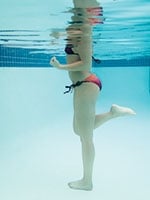
When temperatures soar, working out may be the last thing you want to do. However, a scorching summer day doesn't have to be a fitness death sentence—you can get your sweat on while cooling down in the nearest pool. Water exercise provides a low-impact, total-body workout that won't leave you pulling a sticky t-shirt off your back.
With the temperature up, why not take your workout to the water? Water exercise is a great form of activity that can increase strength, flexibility, and cardiovascular health. So, skip the gym and hit the pool on a hot sunny day.
Water rocks because it’s dense
Although a lot of people envision the elderly or injured when thinking of water-based workouts, the rest of us can also see results in the pool.
While water does produce a buoyant effect on the body, thereby reducing our body’s weight by as much as 90 percent, it is also 800 times denser than air, providing greater resistance with less strain. Because of this denseness, water can provide us with a vigorous total-body workout.
Show me the numbers
When submerged, water provides the body with an almost cushioning effect for the limbs and tissues. This cushioning effect also produces resistance, so we require more energy to lift our limbs. This energy is tracked in calories. A 150 lb (68 kg) person can burn approximately 282 calories for an hour of water aerobics and about 563 for water jogging.
Give me pressure
Claudine Blair, owner of Swim Clo Aquatics and Fitness in Vancouver, loves exercising in water because it is non-weight bearing and changes what were once painful movements for her clients to pleasurable ones.
Blair cites the hydrostatic pressure that water produces as one of the biggest benefits of exercising in H2O. Hydrostatic pressure basically massages the body due to water’s denseness, and acts as auxiliary heart pump, increasing circulation throughout the body and back to the heart.
This pressure not only aids in getting fresh blood to the various areas of the body, but also helps to support the joints, providing traction to them and increasing their range of motion.
Water’s cushioning effect is also ideal for individuals who are at risk of further stressing an injury but still want to continue to work out (for instance, stress fractures of the lower limbs in runners), and for individuals who suffer from orthopedic disorders (such as arthritis, knee injuries, and scoliosis). Nevertheless, consult your health care practitioner before beginning a new exercise regimen, especially if you have an injury or a pre-existing condition.
Exercises
Perform each of the following exercises, one right after the other, for 45 seconds per movement.
Once you have completed one circuit, swim two lengths of the pool, rest for a minute, and perform again the number of times recommended for your level.
- Beginner: four times in total
- Intermediate: six times in total
- Advanced: eight times in total
For each of the following exercises, Blair recommends that you
- maintain good posture throughout, keeping your core engaged, your chest lifted, and your shoulders back and down
- place your whole foot down, ensuring that you are not just landing on your toes—perform the exercises as you would on land
- make sure that you feel the resistance of the water and engage the appropriate muscles
While it is important to use your arms in the workout—as this will help elevate your heart rate and burn more calories—focus on your lower body movements first, and then add the arms.
Thirsty like a fish
It is easy to get dehydrated while working out in the heat of summer. Implement these three easy tips so you stay hydrated.
- Drink one to two cups of water before your workout. Don’t start any workout in a dehydrated state.
- Bring your water bottle and place it on the edge of the pool. Simply having it there could be enough of a reminder to sip throughout your workout. You can also try coconut water for a natural and refreshing rehydration alternative.
- Continue to drink even after the workout is done. Water is something that should be consumed throughout the day, not just gulped before and during exercise.
If you ever feel lightheaded, weak, nauseous, or exhausted, it might be heatstroke or sunstroke. Get out of the sun and seek medical attention.
Cross-Country Skiing

Muscles worked: glutes, hamstrings, inner thighs, shoulders
- Jump your legs forward and back (switching legs, so one goes back as the other goes forward), with your arms moving in opposition.
- Focus on your leg driving back to really hit the glutes.
Jumping Jacks


Muscles worked: outer hips, inner thighs, quadriceps, core, lateral deltoid, rotator cuff
- Start with your feet together and arms bent at 90 degrees and by your sides.
- Jump both legs out, and at the same time, lift both bent arms up to shoulder height—keep the arms underwater for the best effect.
- While jumping the legs out and in, focus on “powering in” to target the inner thighs, or “powering out” to target the outer hips.
Outer Leg Lift

Muscles worked: outer hips, core
- Stand with your left side facing the pool wall, feet together and holding onto the edge of the pool with the left hand.
- Lift the right leg out to the side, leading with the heel and back to centre.
- When at the halfway point, turn around to do the other side (lifting the left leg).
Running

Muscles worked: quadriceps, hip flexors, core, shoulders
- Standing in one spot, drive your knees up one at a time as fast as you can while pumping your arms.
- Once you get into the rhythm of “running” on the spot, place your focus on driving your legs down toward the pool floor.
Hamstring Curls (with alternating bicep curl)

Muscles worked: hamstrings, glutes, biceps
- Kick your heels up to your buttocks, alternating legs. While you do, bend the opposite elbow and curl the hand up to the shoulder like a bicep curl.
- When kicking your heel to your bum, make sure that your knees stay under your hips.




